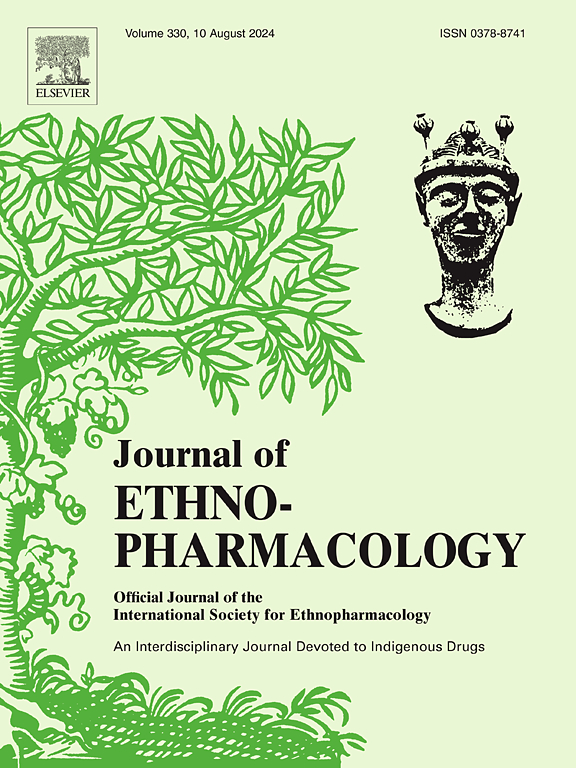Danshen-Chuanxiong-Honghua ameliorates neurological function and inflammation in traumatic brain injury in rats via modulating Ghrelin/GHSR
IF 4.8
2区 医学
Q1 CHEMISTRY, MEDICINAL
引用次数: 0
Abstract
Ethnopharmacological relevance
Guanxin II, proposed by Chen Keji (National master of traditional Chinese medicine), possesses neuroprotective effect. Interestingly, its simplified prescription Danshen-Chuanxiong-Honghua (DCH) can also clinically ameliorate cerebral impairment and improve spatial cognitive deficits, similar to the function of original formula.
Aim of the study
We aimed to elucidate the rationality of DCH's natural existence, qualitatively identify DCH-derived phytochemicals, thereby to validate cerebral protective effect, and expose the potential mechanism of DCH and its main absorbed compound ferulic acid (FA).
Materials and methods
The natural rationality of DCH's existence for treating TBI was verified using data mining. The qualitative analysis of DCH extract-derived phytochemicals was conducted through liquid chromatography with mass spectrometry (LC-MS). Controlled cortical impact (CCI) was chosen to establish TBI model. Neurological behavior tests, blood-brain barrier (BBB) permeability test, brain water content measurement, and proinflammatory factors consisting of IL-6, IL-1β, and TNF-α of plasma, and HPA axis-related hormone levels of DA, NA, 5-HT, ghrelin, and BDNF in hippocampus were analyzed by enzyme-linked immunosorbent assay. Network pharmacology was employed to predict potential targets and pathways of DCH intervening TBI. Growth hormone secretagogue receptor (GHSR) antagonist [D-Lys3]-GHRP-6 (D-Lys3) was injected intraperitoneally in TBI rats after waking up. Molecular docking and pharmacological experiment with D-Lys3 were used to verify the pathway.
Results
Twenty-six phytochemicals were identified based on LC-MS. FA, as the primary contributor of DCH, alleviated disruption of BBB and reduced brain edema, suppressed the secretion of proinflammatory factors, such as IL-6, IL-1β, TNF-α, as well as HPA axis-related hormones such as DA, NA, and 5-HT, and ghrelin, and BDNF by regulating the Ghrelin/GHSR pathway. These results were validated by GHSR receptor antagonist, as well as molecule docking.
Conclusions
Taken together, DCH, when prescribed for the treatment of TBI, has a certain degree of reasonableness. FA, as the main absorbed component, demonstrated a similar function to DCH in improving the blood-brain barrier, promoting neural recovery, and anti-inflammatory effects in TBI rats, primarily via modulating Ghrelin/GHSR.

求助全文
约1分钟内获得全文
求助全文
来源期刊

Journal of ethnopharmacology
医学-全科医学与补充医学
CiteScore
10.30
自引率
5.60%
发文量
967
审稿时长
77 days
期刊介绍:
The Journal of Ethnopharmacology is dedicated to the exchange of information and understandings about people''s use of plants, fungi, animals, microorganisms and minerals and their biological and pharmacological effects based on the principles established through international conventions. Early people confronted with illness and disease, discovered a wealth of useful therapeutic agents in the plant and animal kingdoms. The empirical knowledge of these medicinal substances and their toxic potential was passed on by oral tradition and sometimes recorded in herbals and other texts on materia medica. Many valuable drugs of today (e.g., atropine, ephedrine, tubocurarine, digoxin, reserpine) came into use through the study of indigenous remedies. Chemists continue to use plant-derived drugs (e.g., morphine, taxol, physostigmine, quinidine, emetine) as prototypes in their attempts to develop more effective and less toxic medicinals.
 求助内容:
求助内容: 应助结果提醒方式:
应助结果提醒方式:


